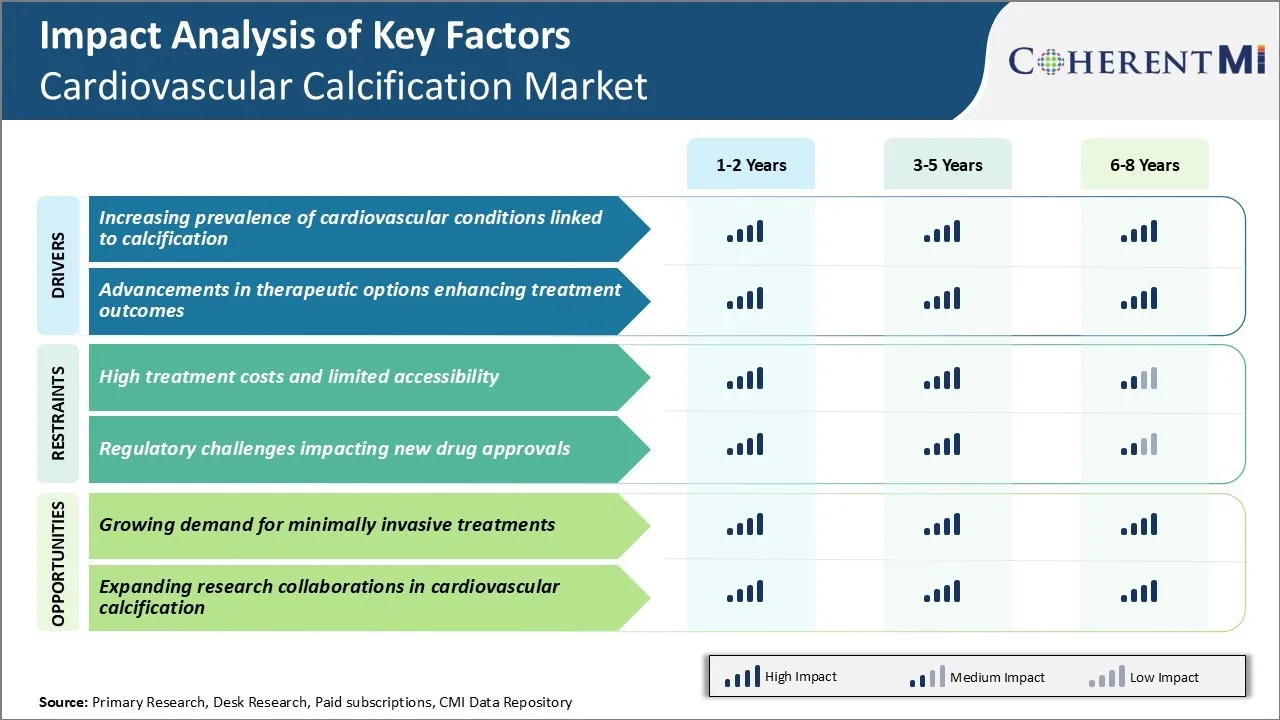Cardiovascular Calcification Market Trends
Market Driver - Increasing Prevalence of Cardiovascular Conditions Linked to Calcification
The increasing prevalence of cardiovascular conditions that are linked with calcification poses a major driver for the growth of the cardiovascular calcification market. Various lifestyle changes such as unhealthy diet, lack of physical activity, smoking and high levels of stress have significantly contributed to the rising incidence of cardiovascular diseases over the past few decades. According to studies, cardiovascular diseases have become one of the leading causes of mortality worldwide. Many CV conditions involve calcification of the arteries and heart valves over time which can limit blood flow and greatly impact heart function if left untreated.
Calcification often emerges as an underlying complication of other cardiac problems like atherosclerosis, valvular heart disease and coronary artery disease. The prolonged exposure to inflammation and damage increases the risk of calcium deposits developing within the tissues of the cardiovascular system. It has been found that as people age, the level of calcification in their arteries and valves gradually rises. Furthermore, medical conditions like diabetes, kidney disease and chronic kidney also heighten the risks of abnormal calcification. With populations globally getting older and lifestyle diseases becoming more rampant, it is predictable that cases of calcified cardiovascular structures will keep multiplying in the future.
Market Driver - Combating Cardiac Calcification with Advanced Treatment Options
Considerable efforts are being made by companies to develop more effective therapeutic solutions that can aid in halting or reversing the progression of calcification. Some of the latest approaches gaining interest include calcium-chelating agents, sodium thiosulfate, bisphosphonates and localized drug-delivery therapies. These treatments work by removing excess calcium from tissues using chemical bonding or altering cellular activity and mineralization pathways involved in the calcification process.
Many clinical trials are ongoing to evaluate the safety and efficacy of such emerging anti-calcifying treatments, especially for conditions where current solutions are inadequate. Advancement in cardiac imaging technologies further aids identification and monitoring of calcified lesions. Combined with innovative therapies, improved visualization and localization of calcium deposits is supporting more targeted and minimally invasive procedures.
With persistent R&D focus on decalcifying strategies, availability of superior monitoring and localized treatment options are positively impacting outlook. They offer physicians and patients an advantage in slowing, stopping or possibly reversing the formation of hard, calcium stones in cardiovascular structures. This expands the choice of minimally invasive treatments and supports better management of chronic cardiac problems linked to calcification. Ultimately, it is the development of superior solutions for combating calcification at various stages that will drive adoption and growth prospects for participants in this specialized field.

Market Challenge - High Treatment Costs and Limited Accessibility
One of the key challenges facing the cardiovascular calcification market is the high costs associated with treating cardiovascular conditions. Developing new treatments and therapies to help manage cardiovascular calcification often requires extensive research and clinical trials. This results in high development costs for pharmaceutical and device companies.
Once treatments receive regulatory approval, the costs of manufacturing, marketing, and distributing new treatments also adds to the overall price. As a result, many novel and promising therapies can be costly for healthcare systems and patients. This high economic burden limits widespread adoption and accessibility of treatments, especially in developing countries and for uninsured or underinsured patients.
The high costs of treatments like cardiovascular stents and angioplasty procedures remain out of reach for large populations globally. Increased research into more cost-effective therapies could help address this challenge and expand access to needed care.
Market Opportunity - Growing Demand for Minimally Invasive Treatments
A major opportunity in the cardiovascular calcification market is the growing demand for minimally invasive treatment options. As cardiovascular conditions increase in prevalence worldwide due to aging populations and rising rates of obesity and diabetes, more patients are seeking treatments that reduce recovery times and minimize hospital stays.
Minimally invasive techniques like Transcatheter Aortic Valve Replacement (TAVR) are becoming increasingly popular alternatives to open-heart surgery, as they offer substantial benefits in terms of reduced surgical risks, scarring, and pain for patients. Advancements in areas like catheter-based excimer laser angioplasty also enable clearing of calcified arteries using small catheter devices inserted via small incisions rather than open vascular surgery.
The demand for such minimally invasive treatments is anticipated to grow substantially in the coming years. Device and technology companies focused on developing novel minimally invasive solutions for cardiovascular care can capitalize on this significant market opportunity.